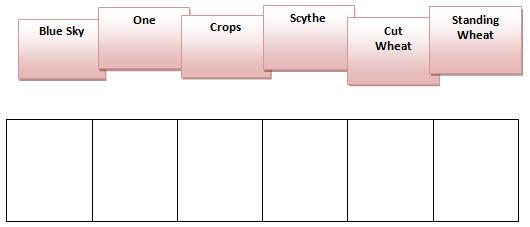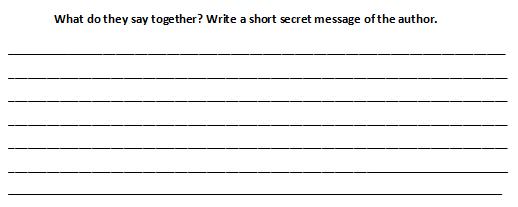THEME: Landscape
LESSON PLAN TITLE: Decoding Pictures
SKILLS COVERED: practicing sounds and phonetic symbols, speaking, prepositions, analyzing primary sources, critical thinking/writing, comparing.
GENERAL GOALS: Developing cross-cultural awareness of post Civil war period in America, drawing parallels of life in the field of Russian and American people, decoding symbols in paintings
SPECIFIC OBJECTIVES: students will learn 18 new vocabulary words; students will practise phonetic symbols; students will learn how to decode specific symbols in Homer’s painting; students will learn word patterns with prepositions that will help them describe a picture.
MATERIALS/VISUAL AIDS: Worksheets (see Appendix), smartboard or projector+screen, high-speed Internet access
Pre-task: it is strongly recommended to read the article about Winslow Homer’s painting in the Picturing America Teachers’ Resource Book. Depending on the level of students it can be done by students themselves (intermediate or upper-intermediate levels) or a teacher can introduce this topic to the class (pre-intermediate level). It is essential to mention historic background of the painting, Civil War, surrender at Appomattox, Northern and Southern states.
Exercise 1. Vocabulary guessing. Vocabulary and Pronunciation. Group work.
Students are divided into two groups. The painting “The Veteran in a New Field” is hung in front of them. Group 1 receives Worksheet 1 and Group 2 gets Worksheet 2 (see Appendix 1-2). Each worksheet contains the list of words with definitions and sounds. Each worksheet has gaps that should be filled in. A student from the first group reads the definition and pronounces the sound that is given in brackets. Having a look at the picture a student from the second group tries to guess the word. Groups make guesses in turns, the winner is the group that completes the chart without mistakes. Both groups can be winners.
| TEACHERS WORKSHEET |
VETERAN [e] |
a former member of army who was fighting with the enemy |
SOLDIER [?u] |
A person who serves in the army |
SCYTHE [ai] |
A tool for cutting crops |
WHEAT [i:] |
A grain that used to make flour and bread |
GRAIN [ei] |
Something that was grown for food in the field, seeds of rice or wheat |
CUT [?] |
To divide into pieces with something sharp |
CLOUD [au] |
A visible mass of tiny drops of water in the sky |
BLUE [u:] |
A color between green and violet, color of bright sky or sea in a sunny day |
SUSPENDERS [e] |
a pair of bands that go over the shoulders and are fixed to their trousers at the front and back so the trousers don’t fall down |
HAT [?] |
A piece of clothes that covers head |
REAPER [i:] |
The one who cuts the wheat |
HARVEST [a:] |
Something that grows in the field and then used for food |
AUTUMN [?:] |
A season that follows summer, when the school year begins |
MIDDAY [ei] |
Twelve o’clock in the day |
HORIZON [ai] |
An imaginary line where it seems that earth and sky meet |
JACKET [?] |
Waist-long coat also worn by soldiers |
FIELD [i:] |
An open land where people grow crops |
MOW [au] |
Cut down the crop |
Then students group the words according to the single vowel sounds and diphthongs.
Exercise 2. Prepositions. Discussion. Group work.
In the sky
In cut wheat
In the standing wheat
On the horizon
To one’s left/right
Phrases with prepositions appear on the blackboard/ smartboard or on the screen. Ask your students to look at the picture once again. Explain that a lot of famous painters started as copyists, that is before painting their own pictures they copied paintings of other famous artists. Cite French impressionist painter Edgar Degas: “You have to copy and recopy the masters,” he insisted, “and it’s only after having proved oneself as a good copyist that you can reasonably try to do a still life of a radish.”[1]. If your students are of intermediate and upper-intermediate level you can let them read the article first http://www.smithsonianmag.com/arts-culture/master.html (see 1 in References).
Tell your students that they are going to try themselves as copyists of Winslow Homer and make a first rough sketch of the painting. Let them divide a piece of paper into three bands like a flag. The first band will be the sky, second – the standing wheat, and third – cut wheat. Students are grouped in 3-5 people and their task is to place the figure of a veteran in the right place. They should discuss where will be his head (in the sky, in the middle), his body (in the standing wheat), his legs (in cut wheat). While they are doing this go round the classroom, check if they’re performing it right and encourage their thoughts about the meaning of veteran’s location. Why is his head in the sky? Why his feet are buried in the cut wheat? Is it a military jacket that is lying to his right? Where is the sun supposed to be? Then groups describe what they have drawn using new vocabulary and preposition patterns and share their thoughts about the meaning of it. E.g. We have drawn veteran’s jacket to his right. His feet are in cut wheat and head in the sky.
Exercise 3. Symbols. Analysis
Each student receives a worksheet (see Appendix 3). A teacher either points out symbols mentioned above himself or writes these words on the blackboard/ projects on the smartboard. Now tell your students to look at this picture as if it was some kind of a secret message. All secret messages are written in symbols and this painting is no exception. Each subject of it is a symbol and it stands for some idea. For example blue sky above veteran’s head that is nearly cloudless what can it be? Why is the veteran working alone in the large field? What does cut or standing wheat symbolize? And so on. Students discuss it with a partner or in small groups. After that each student should write a short secret message that Winslow Homer encoded in the painting.
You can check possible answers and other cues for analysis on (or you can print it out beforehand) http://edsitement.neh.gov/lesson_images/lesson803/HomerInteractPict.pdf
Exercise 4. Listening. (Intermediate and Upper-Intermediate Level)
Now students can compare their observations with analysis made by James McPherson—Professor Emeritus of American history at Princeton University and distinguished Civil War scholar. Podcasts and a transcript are available on http://www.metmuseum.org/special/americanstories/objectView.aspx?oid=4&sid=4 .
Home-task
Students should compare the painting by Winslow Homer with Russian paintings. For example they can visit Tretyakov Gallery interactively (http://www.tretyakovgallery.ru/) and see what is the same and what differs in the Russian field of 19th century. Explain that field represents lifestyle of people of that time, let students pay attention to the three bands: sky, crops and ground. What is different and what is the same? How many people are there? What are they doing? Where are they located in the painting? In a small group students should make a project about a comparison of “The Veteran in a New Field” with some Russian painting, touching upon similar and different things and producing a short analysis, that is decoding painter’s secret message. Students can make a poster or PowerPoint presentation with a Russian painting on a sheet/slide and symbols that they have found, secret message appear in the end.
Recommended pictures:
- Venetsianov, Aleksey Gavrilovich “In the ploughed field. Spring” . First half of the 1820s, oil on canvas 51,2 x 65,5
http://www.tretyakovgallery.ru/en/collection/_show/image/_id/135
- Venetsianov, Aleksey Gavrilovich “Harvesting. Summer” Mid 1820s, oil on canvas 60 ő 48,3
http://www.tretyakovgallery.ru/en/collection/_show/image/_id/2513
- Venetsianov, Aleksey Gavrilovich “Cutting hay” Mid-1820s, oil on canvas 66 x 54
http://www.tretyakovgallery.ru/en/collection/_show/image/_id/136
- Klodt von Yurgensburg, Mikhail Konstantinovich “On a Plowed Field” 1872,
oil on canvas 71 x 131,2
http://www.tretyakovgallery.ru/en/collection/_show/image/_id/191
References:
1. Harriss, Joseph A. “Master Class”. Smithsonian magazine, October 2002. Article from the Smithsonian magazine about copyists. http://www.smithsonianmag.com/arts-culture/master.html
2. Oxford Dictionary of English, Revised Edition. Oxford University Press, 2005.
3. Picturing America Teachers Resource Book, 2007.
4. www.metmuseum.org
5. www.picturingamerica.neh.gov
6. www.tretyakovgallery.ru
APPENDIX 1.
| GROUP 1 |
|
[e] a former member of army who was fighting with the enemy |
SOLDIER |
[?u] A person who serves in the army |
|
[ai] A tool for cutting crops |
WHEAT |
[i:] A grain that used to make flour and bread |
|
[ei] Something that was grown for food in the field, seeds of rice or wheat |
CUT |
[?] To divide into pieces with something sharp |
|
[au] A visible mass of tiny drops of water in the sky |
BLUE |
[u:] A color between green and violet, color of bright sky or sea in a sunny day |
|
[e] a pair of bands that go over the shoulders and are fixed to their trousers at the front and back so the trousers don’t fall down |
HAT |
[?] A piece of clothes that covers head |
|
[i:] The one who cuts the wheat |
HARVEST |
[a:] Something that grows in the field and then used for food |
|
[?:] A season that follows summer, when the school year begins |
MIDDAY |
[ei] Twelve o’clock in the day |
|
[ai] An imaginary line where it seems that earth and sky meet |
JACKET |
[?] Waist-long coat also worn by soldiers |
|
[i:] An open land where people grow crops |
MOW |
[au] Cut down the crop |
APPENDIX 2.
| GROUP 2 |
VETERAN |
[e] a former member of army who was fighting with the enemy |
|
[?u] A person who serves in the army |
SCYTHE |
[ai] A tool for cutting crops |
|
[i:] A grain that used to make flour and bread |
GRAIN |
[ei] Something that was grown for food in the field, seeds of rice or wheat |
|
[?] To divide into pieces with something sharp |
CLOUD |
[au] A visible mass of tiny drops of water in the sky |
|
[u:] A color between green and violet, color of bright sky or sea in a sunny day |
SUSPENDERS |
[e] a pair of bands that go over the shoulders and are fixed to their trousers at the front and back so the trousers don’t fall down |
|
[?] A piece of clothes that covers head |
REAPER |
[i:] The one who cuts the wheat |
|
[a:] Something that grows in the field and then used for food |
AUTUMN |
[?:] A season that follows summer, when the school year begins |
|
[ei] Twelve o’clock in the day |
HORIZON |
[ai] An imaginary line where it seems that earth and sky meet |
|
[?] Waist-long coat also worn by soldiers |
FIELD |
[i:] An open land where people grow crops |
|
[au] Cut down the crop |
APPENDIX 3. Student’s Worksheet
Find these symbols in the painting. What do they stand for? Write down a meaning for each one.


|

